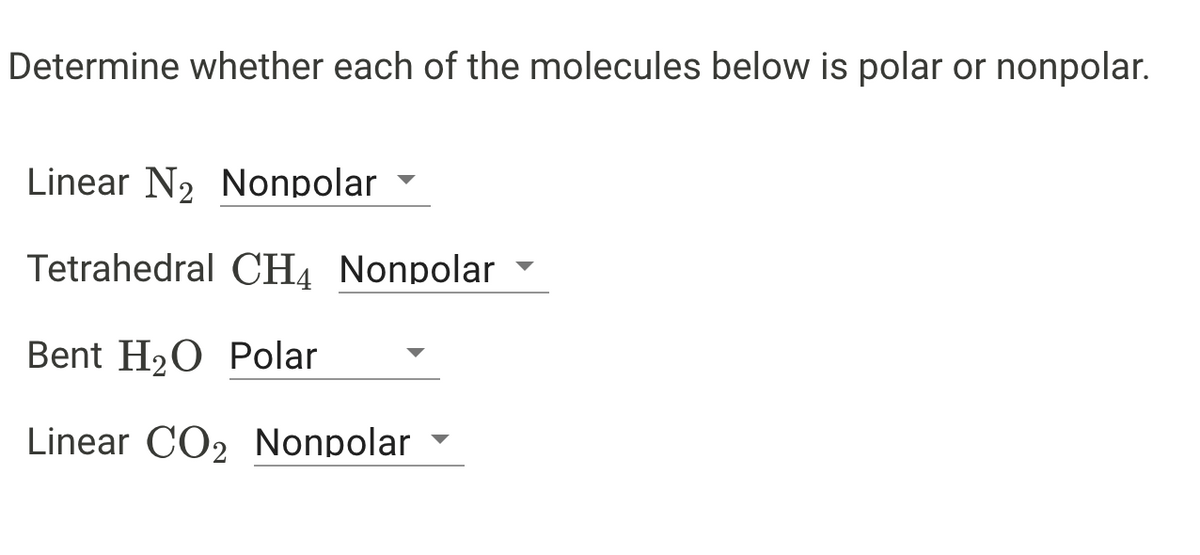Which statement best explains how viscosity relates to intermolecular forces? Select one: When the molecules have similar intermolecular forces, the molecules get better at sticking together, so they resist movement (more viscous). When the molecules have weak intermolecular forces, it takes more energy to move them, so they resist movement (more viscous). When the molecules have strong intermolecular forces, they stick together more, so they resist movement (more viscous). When the molecules have unmatched intermolecular forces, the molecules repel each other. As they push each other apart, the liquid gets much more flow-y (less viscous).
Which statement best explains how viscosity relates to intermolecular forces? Select one: When the molecules have similar intermolecular forces, the molecules get better at sticking together, so they resist movement (more viscous). When the molecules have weak intermolecular forces, it takes more energy to move them, so they resist movement (more viscous). When the molecules have strong intermolecular forces, they stick together more, so they resist movement (more viscous). When the molecules have unmatched intermolecular forces, the molecules repel each other. As they push each other apart, the liquid gets much more flow-y (less viscous).
Chemistry for Engineering Students
4th Edition
ISBN:9781337398909
Author:Lawrence S. Brown, Tom Holme
Publisher:Lawrence S. Brown, Tom Holme
Chapter8: Molecules And Materials
Section: Chapter Questions
Problem 8.92PAE
Related questions
Question

Transcribed Image Text:Which statement best explains how viscosity relates to intermolecular forces?
Select one:
When the molecules have similar intermolecular forces, the molecules get better at sticking together, so they resist movement
(more viscous).
When the molecules have weak intermolecular forces, it takes more energy to move them, so they resist movement (more
viscous).
O When the molecules have strong intermolecular forces, they stick together more, so they resist movement (more viscous).
When the molecules have unmatched intermolecular forces, the molecules repel each other. As they push each other apart, the
liquid gets much more flow-y (less viscous).

Transcribed Image Text:Determine whether each of the molecules below is polar or nonpolar.
Linear N2 Nonpolar
Tetrahedral CH4 Nonpolar
Bent H20 Polar
Linear CO2 Nonpolar
Expert Solution
This question has been solved!
Explore an expertly crafted, step-by-step solution for a thorough understanding of key concepts.
This is a popular solution!
Trending now
This is a popular solution!
Step by step
Solved in 2 steps

Knowledge Booster
Learn more about
Need a deep-dive on the concept behind this application? Look no further. Learn more about this topic, chemistry and related others by exploring similar questions and additional content below.Recommended textbooks for you

Chemistry for Engineering Students
Chemistry
ISBN:
9781337398909
Author:
Lawrence S. Brown, Tom Holme
Publisher:
Cengage Learning

Introductory Chemistry: An Active Learning Approa…
Chemistry
ISBN:
9781305079250
Author:
Mark S. Cracolice, Ed Peters
Publisher:
Cengage Learning

General Chemistry - Standalone book (MindTap Cour…
Chemistry
ISBN:
9781305580343
Author:
Steven D. Gammon, Ebbing, Darrell Ebbing, Steven D., Darrell; Gammon, Darrell Ebbing; Steven D. Gammon, Darrell D.; Gammon, Ebbing; Steven D. Gammon; Darrell
Publisher:
Cengage Learning

Chemistry for Engineering Students
Chemistry
ISBN:
9781337398909
Author:
Lawrence S. Brown, Tom Holme
Publisher:
Cengage Learning

Introductory Chemistry: An Active Learning Approa…
Chemistry
ISBN:
9781305079250
Author:
Mark S. Cracolice, Ed Peters
Publisher:
Cengage Learning

General Chemistry - Standalone book (MindTap Cour…
Chemistry
ISBN:
9781305580343
Author:
Steven D. Gammon, Ebbing, Darrell Ebbing, Steven D., Darrell; Gammon, Darrell Ebbing; Steven D. Gammon, Darrell D.; Gammon, Ebbing; Steven D. Gammon; Darrell
Publisher:
Cengage Learning


Chemistry: An Atoms First Approach
Chemistry
ISBN:
9781305079243
Author:
Steven S. Zumdahl, Susan A. Zumdahl
Publisher:
Cengage Learning

Chemistry
Chemistry
ISBN:
9781305957404
Author:
Steven S. Zumdahl, Susan A. Zumdahl, Donald J. DeCoste
Publisher:
Cengage Learning